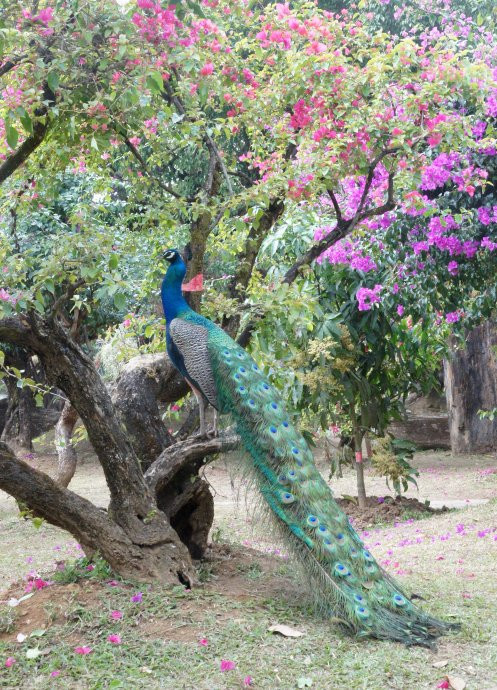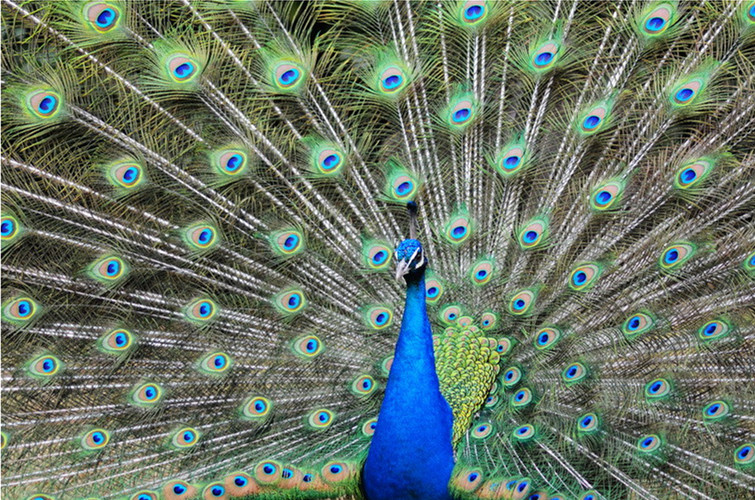Peacock in Yunnan
Peafowl Species
Peafowl include two Asiatic species:
- The blue or Indian peafowl, native to India and Sri Lanka
- The green peafowl, found in Burma, Indochina, and Java
Additionally, there is one African species:
- The Congo peafowl, which is native only to the Congo Basin
These birds belong to the genera Pavo and Afropavo of the Phasianidae family (pheasants and their allies). They are known for the male’s piercing call and, particularly in the Asiatic species, his extravagant eye-spotted tail feathers, which are displayed as part of a courtship ritual. The term “peacock” refers specifically to the male; the female is known as a peahen, and the young are called peachicks.
Unlike chickpeas, these birds are unique to their genus and known for their striking features.
Physical Features
In common with other members of the Galliformes, peacocks possess metatarsal spurs (or “thorns”) on their legs, which are used during intraspecific territorial fights.
The peacock’s elaborate iridescent coloration and large “train” have sparked extensive scientific debate. Charles Darwin suggested these features served to attract females, evolving through sexual selection. More recently, Amotz Zahavi’s handicap theory proposed that the showy features act as honest signals of the male’s fitness, as less fit males would be disadvantaged by surviving with such large and conspicuous structures.
Cultural Significance in Yunnan
Peacocks as Sacred Birds
In Yunnan, particularly among the Dai minority, peacocks are considered sacred birds. They are believed to bring happiness and good luck. The Dai people have formed a deep bond with these birds over centuries. Dehong, in Yunnan Province, is often called the “home to peacocks” due to the significant population of these birds in the region.
The Peacock Dance
Each year, in mid-April, the Dai people hold a grand ceremony as part of the Water-sprinkling Festival. During this celebration, they perform the peacock dance, a graceful dance that symbolizes happiness and luck. This dance has been designated as an intangible cultural heritage of China.
The dance is believed to have originated more than 1,000 years ago when a tribal head created it to honor the peacock. Historically, men performed the dance accompanied by gongs and drums, while wearing golden helmets, masks, and costumes with decorations resembling peacock wings.
Since the establishment of New China in 1949, the dance has evolved, and women began to perform it without masks, allowing them to express emotions through their eyes and facial expressions. The dancers wear light costumes, enabling them to move gracefully, mimicking the peacock’s movements.
Folklore and Totem
The Peacock Princess is one of the best-known legends among the Dai people. The tale dates back more than 300 years and tells the story of a prince in Xishuangbanna who fell in love with the youngest of seven peacock princesses. The prince hid her peacock dress, which led to her staying behind, and they eventually married, living happily ever after.
This deep affection for peacocks has influenced Dai culture, with many people naming their daughters “Peacock” in the hopes that they will grow into beautiful, pure women like the legendary Peacock Princess.
Peacocks in Dai Art and Culture
Peacock motifs are widely incorporated into the daily life of the Dai people. These patterns are embroidered, printed, and dyed on various items such as quilts, towels, curtains, and women’s skirts and bags. Additionally, they appear in house decorations, Buddhist temple murals, and sculptures throughout areas inhabited by the Dai people.
The peacock dance, along with the folk customs and legends surrounding peacocks, reflects the artistic and cultural values of the Dai community. The dance is performed during festivals, such as the Door-opening and Door-closing festivals, as well as for special occasions in Dai villages.
The Dai people’s connection to peacocks is a testament to their belief in the bird’s symbolic power to bring beauty, grace, and happiness to their lives.













